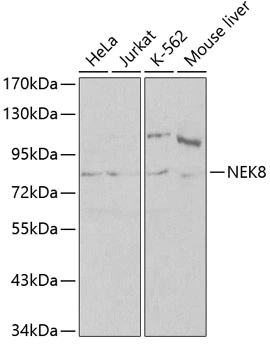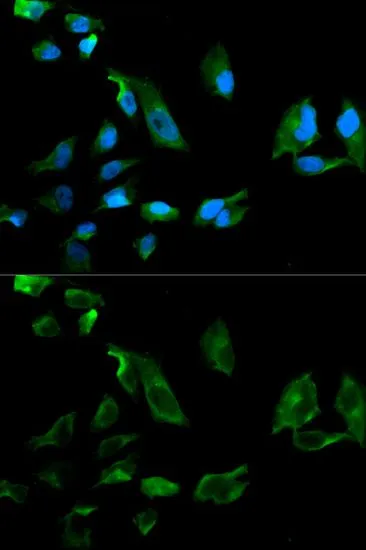
WB analysis of various sample lysates using GTX54586 NEK8 antibody. Dilution : 1:1000 Loading : 25microg per lane
NEK8 antibody
GTX54586
ApplicationsImmunoFluorescence, Western Blot, ImmunoCytoChemistry
Product group Antibodies
TargetNEK8
Overview
- SupplierGeneTex
- Product NameNEK8 antibody
- Delivery Days Customer7
- Application Supplier NoteWB: 1:500 - 1:2000. ICC/IF: 1:50 - 1:200. *Optimal dilutions/concentrations should be determined by the researcher.Not tested in other applications.
- ApplicationsImmunoFluorescence, Western Blot, ImmunoCytoChemistry
- CertificationResearch Use Only
- ClonalityPolyclonal
- ConjugateUnconjugated
- Gene ID284086
- Target nameNEK8
- Target descriptionNIMA related kinase 8
- Target synonymsJCK, NEK12A, NPHP9, PKD8, RHPD2, serine/threonine-protein kinase Nek8, NIMA (never in mitosis gene a)- related kinase 8, NIMA-family kinase NEK8, NIMA-related kinase 12a, nephrocystin 9, never in mitosis A-related kinase 8, nimA-related protein kinase 8, nima-related protein kinase 12a, serine/thrionine-protein kinase NEK8
- HostRabbit
- IsotypeIgG
- Protein IDQ86SG6
- Protein NameSerine/threonine-protein kinase Nek8
- Scientific DescriptionThis gene encodes a member of the serine/threionine protein kinase family related to NIMA (never in mitosis, gene A) of Aspergillus nidulans. The encoded protein may play a role in cell cycle progression from G2 to M phase. Mutations in the related mouse gene are associated with a disease phenotype that closely parallels the juvenile autosomal recessive form of polycystic kidney disease in humans. [provided by RefSeq, Jul 2008]
- Storage Instruction-20°C or -80°C,2°C to 8°C
- UNSPSC12352203






